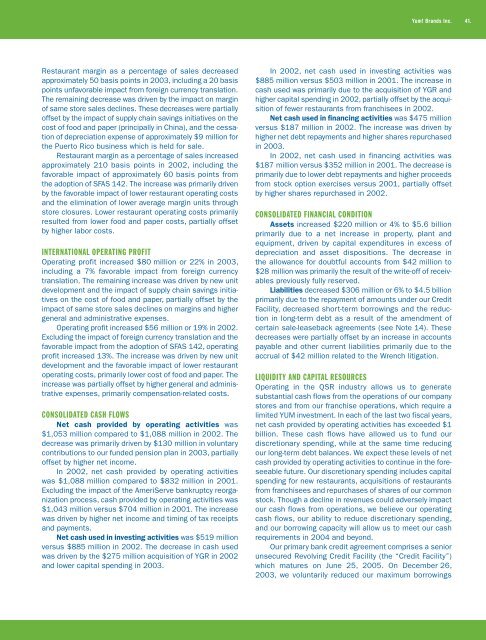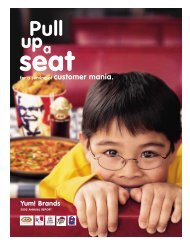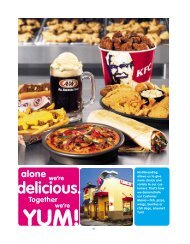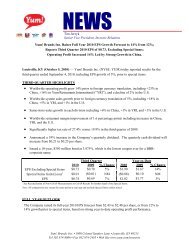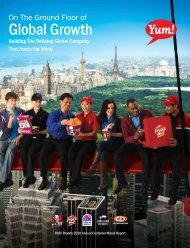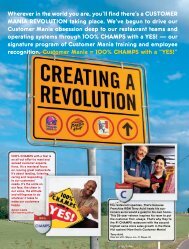Multibranding - Yum!
Multibranding - Yum!
Multibranding - Yum!
You also want an ePaper? Increase the reach of your titles
YUMPU automatically turns print PDFs into web optimized ePapers that Google loves.
Restaurant margin as a percentage of sales decreased<br />
approximately 50 basis points in 2003, including a 20 basis<br />
points unfavorable impact from foreign currency translation.<br />
The remaining decrease was driven by the impact on margin<br />
of same store sales declines. These decreases were partially<br />
offset by the impact of supply chain savings initiatives on the<br />
cost of food and paper (principally in China), and the cessation<br />
of depreciation expense of approximately $9 million for<br />
the Puerto Rico business which is held for sale.<br />
Restaurant margin as a percentage of sales increased<br />
approximately 210 basis points in 2002, including the<br />
favorable impact of approximately 60 basis points from<br />
the adoption of SFAS 142. The increase was primarily driven<br />
by the favorable impact of lower restaurant operating costs<br />
and the elimination of lower average margin units through<br />
store closures. Lower restaurant operating costs primarily<br />
resulted from lower food and paper costs, partially offset<br />
by higher labor costs.<br />
INTERNATIONAL OPERATING PROFIT<br />
Operating profit increased $80 million or 22% in 2003,<br />
including a 7% favorable impact from foreign currency<br />
translation. The remaining increase was driven by new unit<br />
development and the impact of supply chain savings initiatives<br />
on the cost of food and paper, partially offset by the<br />
impact of same store sales declines on margins and higher<br />
general and administrative expenses.<br />
Operating profit increased $56 million or 19% in 2002.<br />
Excluding the impact of foreign currency translation and the<br />
favorable impact from the adoption of SFAS 142, operating<br />
profit increased 13%. The increase was driven by new unit<br />
development and the favorable impact of lower restaurant<br />
operating costs, primarily lower cost of food and paper. The<br />
increase was partially offset by higher general and administrative<br />
expenses, primarily compensation-related costs.<br />
CONSOLIDATED CASH FLOWS<br />
Net cash provided by operating activities was<br />
$1,053 million compared to $1,088 million in 2002. The<br />
decrease was primarily driven by $130 million in voluntary<br />
contributions to our funded pension plan in 2003, partially<br />
offset by higher net income.<br />
In 2002, net cash provided by operating activities<br />
was $1,088 million compared to $832 million in 2001.<br />
Excluding the impact of the AmeriServe bankruptcy reorganization<br />
process, cash provided by operating activities was<br />
$1,043 million versus $704 million in 2001. The increase<br />
was driven by higher net income and timing of tax receipts<br />
and payments.<br />
Net cash used in investing activities was $519 million<br />
versus $885 million in 2002. The decrease in cash used<br />
was driven by the $275 million acquisition of YGR in 2002<br />
and lower capital spending in 2003.<br />
<strong>Yum</strong>! Brands Inc. 41.<br />
In 2002, net cash used in investing activities was<br />
$885 million versus $503 million in 2001. The increase in<br />
cash used was primarily due to the acquisition of YGR and<br />
higher capital spending in 2002, partially offset by the acquisition<br />
of fewer restaurants from franchisees in 2002.<br />
Net cash used in financing activities was $475 million<br />
versus $187 million in 2002. The increase was driven by<br />
higher net debt repayments and higher shares repurchased<br />
in 2003.<br />
In 2002, net cash used in financing activities was<br />
$187 million versus $352 million in 2001. The decrease is<br />
primarily due to lower debt repayments and higher proceeds<br />
from stock option exercises versus 2001, partially offset<br />
by higher shares repurchased in 2002.<br />
CONSOLIDATED FINANCIAL CONDITION<br />
Assets increased $220 million or 4% to $5.6 billion<br />
primarily due to a net increase in property, plant and<br />
equipment, driven by capital expenditures in excess of<br />
depreciation and asset dispositions. The decrease in<br />
the allowance for doubtful accounts from $42 million to<br />
$28 million was primarily the result of the write-off of receivables<br />
previously fully reserved.<br />
Liabilities decreased $306 million or 6% to $4.5 billion<br />
primarily due to the repayment of amounts under our Credit<br />
Facility, decreased short-term borrowings and the reduction<br />
in long-term debt as a result of the amendment of<br />
certain sale-leaseback agreements (see Note 14). These<br />
decreases were partially offset by an increase in accounts<br />
payable and other current liabilities primarily due to the<br />
accrual of $42 million related to the Wrench litigation.<br />
LIQUIDITY AND CAPITAL RESOURCES<br />
Operating in the QSR industry allows us to generate<br />
substantial cash flows from the operations of our company<br />
stores and from our franchise operations, which require a<br />
limited YUM investment. In each of the last two fiscal years,<br />
net cash provided by operating activities has exceeded $1<br />
billion. These cash flows have allowed us to fund our<br />
discretionary spending, while at the same time reducing<br />
our long-term debt balances. We expect these levels of net<br />
cash provided by operating activities to continue in the foreseeable<br />
future. Our discretionary spending includes capital<br />
spending for new restaurants, acquisitions of restaurants<br />
from franchisees and repurchases of shares of our common<br />
stock. Though a decline in revenues could adversely impact<br />
our cash flows from operations, we believe our operating<br />
cash flows, our ability to reduce discretionary spending,<br />
and our borrowing capacity will allow us to meet our cash<br />
requirements in 2004 and beyond.<br />
Our primary bank credit agreement comprises a senior<br />
unsecured Revolving Credit Facility (the “Credit Facility”)<br />
which matures on June 25, 2005. On December 26,<br />
2003, we voluntarily reduced our maximum borrowings


